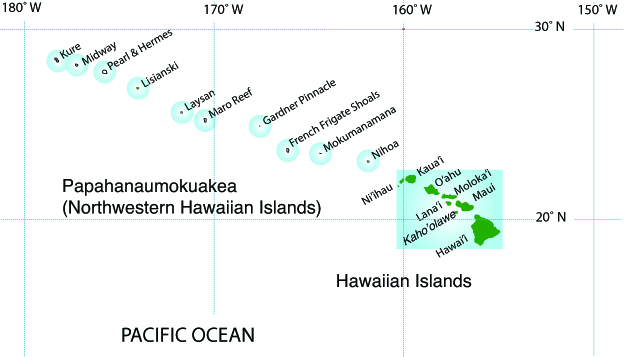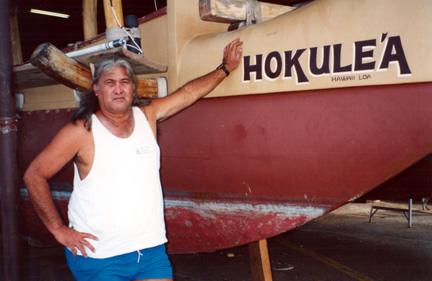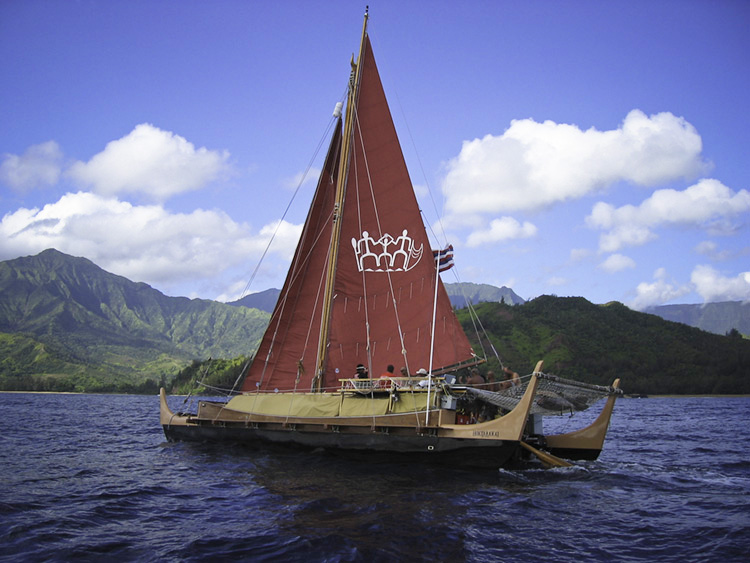PVS Newsletter / December 2004
Navigating Change
“Navigating Change” used Hōkūle‘a as its messenger on a 1,250 mile sail through the Northwestern Hawaiian Islands in May and June of 2004.

More than two years of planning resulted in:
- Thousands of students in Polynesia and the mainland querying crewmembers by satellite phone.
- The development of Navigating Change curricula for 4th and 5th, grades in the Department of Education and other schools by an on-going group of committed teachers and consultants.
- The growth of a new generation of Hokule‘a navigators, captains and crew.
- Outstanding support by the Honolulu Advertiser and its journahst, Jan TenBruggencate, who brought the Navigating Change story to hundreds of thousands of people each day.
- The national "Rachel Carson Sense of Wonder" Award presented to Ann Bell, U.S. Fish and Wildlife Service educator and Hokule‘a crewmember, for her role in Navigating Change.
- Wonderful kokua from Navigating Change participating partners.
Navigating Change Partners:
- Bishop Museum
- U.S. Fish & Wildlife Service
- Northwestern Hawaiian Islands Coral Ecosystem Reserve
- Western Pacific Regional Fishery Management Council
- University of Hawaili School of Ocean and Earth Sciences and Technology
- University of Hawai'i Sea Grant College
- University of Hawaili Center for Hawaiian Studies
- University of Hawaili - Hawai'i Institute of Marine Biology
- Hawai'i Maritime Center
- Hawai'i State Department of Education
- Hawai'i State Department of Land and Natural Resources
- Hawai'i State Department of Business and Economic Development and Tourism
- The Nature Conservancy
- lNational Fish and Wildlife Foundation
For accounts of the voyage by Honolulu Advertiser writer Jan Tenbruggencate, see “Navigating Change: 2003-2004 Voyage to Papahanaumokuakea.”

Hokule‘a sails past Nihoa
Dedication to Clay Bertelmann
We dedicate this newsletter with aloha and love to one of Hawai'i' s great voyagers, Clay Bertelmann. Clay was a Hokule‘a crewmember and captain. He was a visionary in the drivingforce behind the construction, launching and voyaging of Makali‘i. His strong leadership guided many and he possessed a profound clarity of purpose to serve our children and communities. The entire voyaging community will deeply miss him. But his life and his work are carried on through the continued voyaging of Makali‘i.

Our continued love and aloha also goes out to three men who recently passed. They gave so much to voyaging, Hokule‘a, and to all of us in building a very important foundation from which we all continue to benefit.
Wright Bowman Sr.
Abraham Pi'ianaia
Pat Aiu
KAHO'OLAWE: A REUNION AND DEDICATION
A very special sail in 2004 was to the island of Kaho'olawe. We had the opportunity to see the reunion of very important Hawaiian leaders who, for the last 28 years, have worked so hard to recover this sacred Hawaiian island and who are working toward her restoration and healing. It was also an honor to sail there alongside Makali'i and H6kOalaka'i, an event that, in various ways, brought many segments of our communities together.
It was a very powerful time to be with these early pioneers, both in the movement of the recovery of Kaho'olawe as well as the early days of voyaging, and to have the ability for our younger generations to listen to those important early stories. Much of what was shared was also conversations on the purpose and values behind protecting, preserving and growing the Hawaiian culture, and the importance of bringing back pride, culture and kinship to our lands and sea.
Another landmark event was the dedication of the star platform at Kealaikahiki. Kealaikahiki point is considered by many as the most important traditional astronomical sights in the islands of Hawai'i. It may well be the most important school or teaching platform for future training in traditional navigation. It was a special privilege having master navigator Mau Piailug there. His presence brought great strength and mana to the ceremony.
BECOMING A CREWMEMBER By Bruce Blankenfeld
Although Hokule‘a's impact is largely felt in Hawai'i and Polynesia, its crewmembers and supporters come from everywhere. We're often asked how crews are selected. A crew member is chosen because that person wants to be a part of PVS, has strong interest in the canoe and PVS's programs, helps out, attends classroom and on-board training programs, which are intense and lengthy, and because the values that person exemplifies relate to family.
EDUCATION PROGRAMS
Hokule‘a sailed 5,500 miles within Hawai'i in 2004. PVS strategically focused on training 12 new captains in order to meet the growing demand for voyaging education programs. Those programs were able to touch thousands of school children and communities this year. This could not have happened without the tremendous support of many organizations and institutions with which we were able to partner.
A special sail was with Pacific American Foundation's National Pacific American Leadership Institute (NA PALI), which is dedicated to building leadership skills of Pacific American men and women. Our partnership with NA PALI is part of our continued commitment to grow and develop high quality leadership training programs by integrating the canoe with the history and heritage that it represents, the precious ocean and lands of Hawai'i, and our very special communities. We want to thank the leadership of PAF and NA PALI for their most generous support.
Marine Education Training Center (METC)
The growing partnership between PVS and Honolulu Community College's Marine Education Training Center has been very important in creating a home and a place to care for our canoes, and to conduct quality education programs. We want to thank HCC Chancellor Ramsey Pedersen and METC Director Bob Perkins and Educational Specialist II Mark Kimura, for their vision, leadership and tremendous support.

Nainoa with Hōkūle‘a in drydock at METC
HOKUALAKA‘I LAUNCHED
Under the leadership of Chad Baybayan, the voyaging canoe Hokualaka‘i launched from METC on August 14, 2004. Chad has been a Hokule‘a crewmember, captain and navigator since 1977. Through his leadership and direction Hokualaka'i bridges three important entities, the voyaging community, the University of Hawai'i at Hilo and PCinana Leo.
In September, Hokule‘a and Hokualaka‘i sailed together on a 1,000 mile sea trial throughout the state of Hawai'i. It was an honor to sail with her from Hanalei to Hilo. She is proven to be well-designed, sea-worthy and very fast.
Those of us who have admired Chad’s leadership can see what an important impact it has had in developing his younger crew base from Hilo. They sailed Hokualaka‘i with both professionalism and pride and we are all honored by their good work and certainly look forward to future voyages together.

Hokualaka‘i. Photo by Cliff Watson
National Geographic Society SAILS ON HOKULE‘A
A National Geographic Society film crew sailed on Hokule‘a in September as she and Hokualaka‘i voyaged from Hanalei, Kaua'i to the north shore of Moloka'i. The crew was filming for a four-part series called "Light at the Edge of the World."
The program's intent is to celebrate indigenous societies in four different "culture spheres" while examining the perils and damage they experienced and ultimately survived. Polynesia is one of those culture spheres.
The program's director, Andrew Gregg, explains "what we wanted to do aboard Hokule‘a was experience the ancient Polynesian skill of celestial navigation, to not only understand the technique but the cultural significance of the navigator to the people of the Pacific." The group will also be filming in Tahiti, the Marquesas and Rapa Nui.
The program also focuses on the importance of sacred geography to the people of the Andes, the "elasticity" of the brain and the power of Buddhist training in the Himalayas, and the role of the hunt in the lives of the lnuit of Greenland and Northern Canada.
HAWAI'LLOA IN DRYDOCK
The voyaging canoe Hawai'iloa went into dry-dock at the Marine Education Training Center this year. Several cracks have been found in her hulls. Restoration will begin in January 2005 and is expected to take 10 to 12 months to complete.
Partners in her restoration include the Bishop Museum, Friends of H6kOle'a & Hawai'iloa, the Polynesian Voyaging Society, and the Marine Education Training Center (Honolulu Community College).
Ernie Hillman, SeaAlaska's former land manager, who coordinated the choosing and felling of the logs for Hawai'iloa, came to Hawai'i in November to attend a one-day retreat on the restoration. He also gave an inspiring presentation at the Bishop Museum and let us relive Hawai'iloa's voyage to Southeastern Alaska and the forming of life-long friendships. Thank you Ernie!
"ALOHA HOKU"
In May, 2004, 300 friends, relatives and crewmembers gathered at the Marine Education Training Center for "Aloha Hoku," to bid aloha to Hokule‘a and her crew as they embarked on their voyage to the Northwestern Hawaiian Islands. The fundraising dinner featured food from a variety of Hawai'i's finest chefs and entertainment by Amy Hanaiali'i Gilliom, Willie K., and Ka Pa Hula Hawai'i. Mahalo to all PVS friends and supporters who made "Aloha Hoku" such a special and successful event. In the process you helped raise $75,000.00 to support the Polynesian Voyaging Society's education programs and on-going efforts to Navigate Change.
2005 AT A GLANCE
Hokule‘a first entered Hawai'i's waters on March 8th, 1975. That day marked the birth of a movement toward pride and honor and the rebirth of a tradition long lost. Next year marks her 30th anniversary.
In celebration, Hokule‘a will relive a part of her past in a statewide sail, revisiting 31 communities and launching sites such as Kualoa, Honolua Bay, and Kealaikahiki from the middle of February to the middle of August.
The planning of the statewide sail is in the hands of a wonderful committee comprised, in part, of women who were there supporting Hokule‘a from the beginning. Among them: Paige Barber, Moku Froiseth, and Cecilia Lindo. Watch for community celebrations across the state, a large public celebration at Kualoa in March and a fundraising dinner, tentatively in May.
The purpose of the voyage is to acknowledge and thank our early pioneers, mentors and teachers who created the foundation for later generations to continue their voyaging traditions. It is meant to bridge the life and efforts of these early special people with our future generation of leadership, and to provide the critically important ocean training opportunities that will enable the continual development of leaders who must keep our future voyages safe. Fundamentally it is to bring back together as much of the canoe 'ohana as possible.
